Organisational Behaviour Report - Hounslow - Unit 12 - 2019/20
VerifiedAdded on 2023/01/16
|18
|5797
|62
Report
AI Summary
This report offers a comprehensive analysis of organizational behavior, focusing on the key elements of culture, politics, and power and their influence on individual and team performance within Sainsbury. It examines Handy's culture model and the impact of collaborative work environments, as well as the effects of positive and negative organizational politics. The report then delves into motivational theories, including content and process theories, with a specific focus on McClelland’s theory of needs and its application within the company. Furthermore, it differentiates between effective and ineffective teams, highlighting factors such as communication, cooperation, and leadership. Finally, the report explores the application of various organizational behavior philosophies in the context of Sainsbury, providing insights into how these concepts shape the company's operations and employee relations.
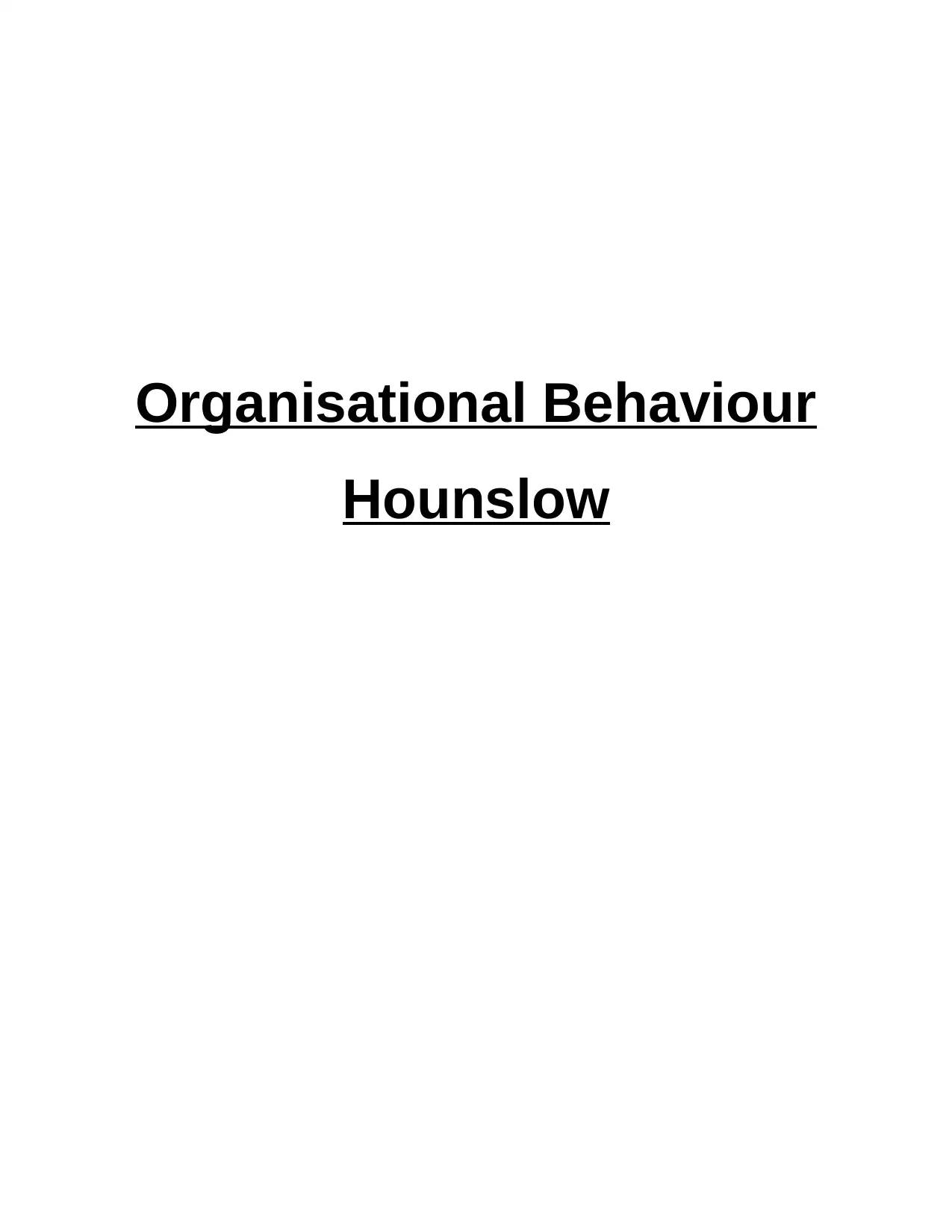
Organisational Behaviour
Hounslow
Hounslow
Paraphrase This Document
Need a fresh take? Get an instant paraphrase of this document with our AI Paraphraser
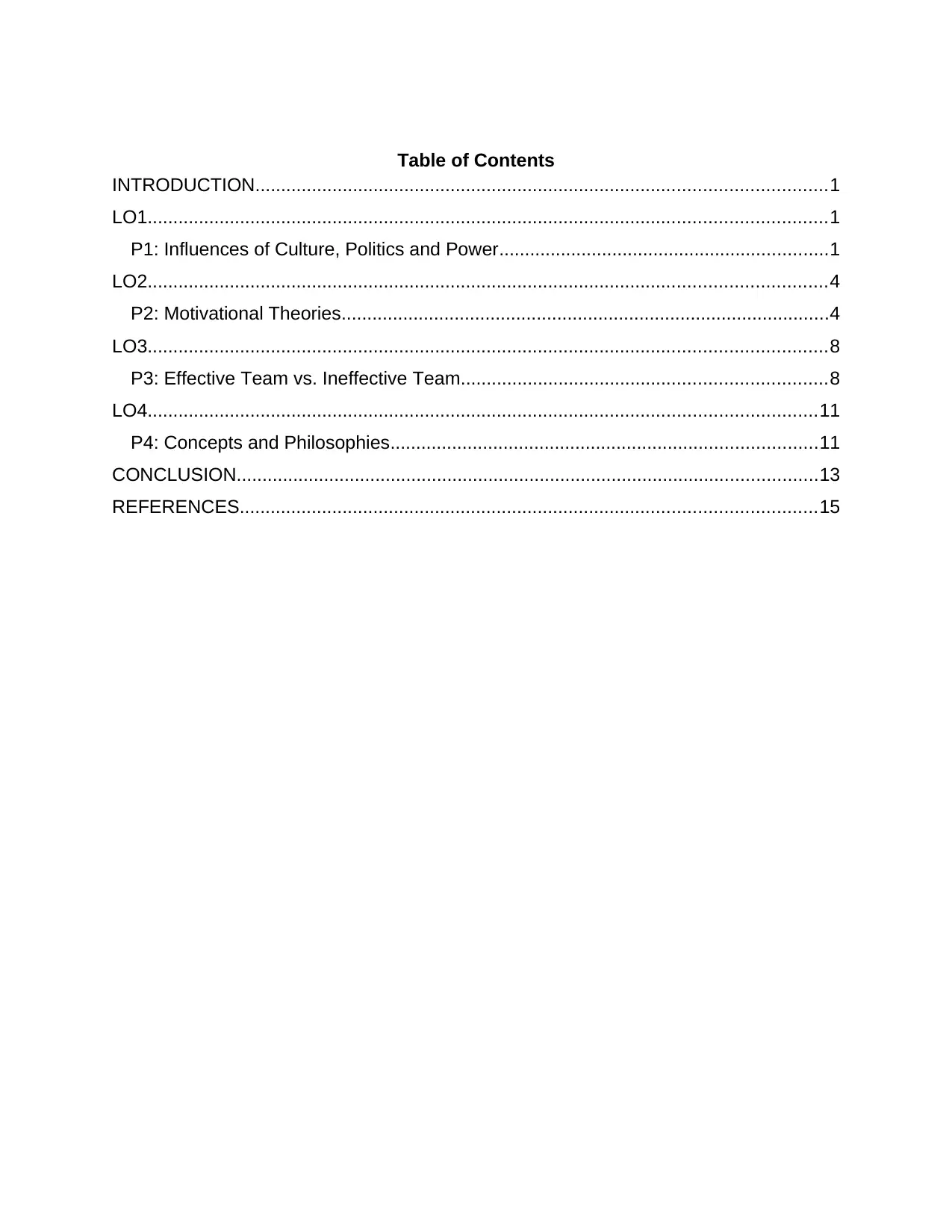
Table of Contents
INTRODUCTION...............................................................................................................1
LO1....................................................................................................................................1
P1: Influences of Culture, Politics and Power................................................................1
LO2....................................................................................................................................4
P2: Motivational Theories...............................................................................................4
LO3....................................................................................................................................8
P3: Effective Team vs. Ineffective Team.......................................................................8
LO4..................................................................................................................................11
P4: Concepts and Philosophies...................................................................................11
CONCLUSION.................................................................................................................13
REFERENCES................................................................................................................15
INTRODUCTION...............................................................................................................1
LO1....................................................................................................................................1
P1: Influences of Culture, Politics and Power................................................................1
LO2....................................................................................................................................4
P2: Motivational Theories...............................................................................................4
LO3....................................................................................................................................8
P3: Effective Team vs. Ineffective Team.......................................................................8
LO4..................................................................................................................................11
P4: Concepts and Philosophies...................................................................................11
CONCLUSION.................................................................................................................13
REFERENCES................................................................................................................15
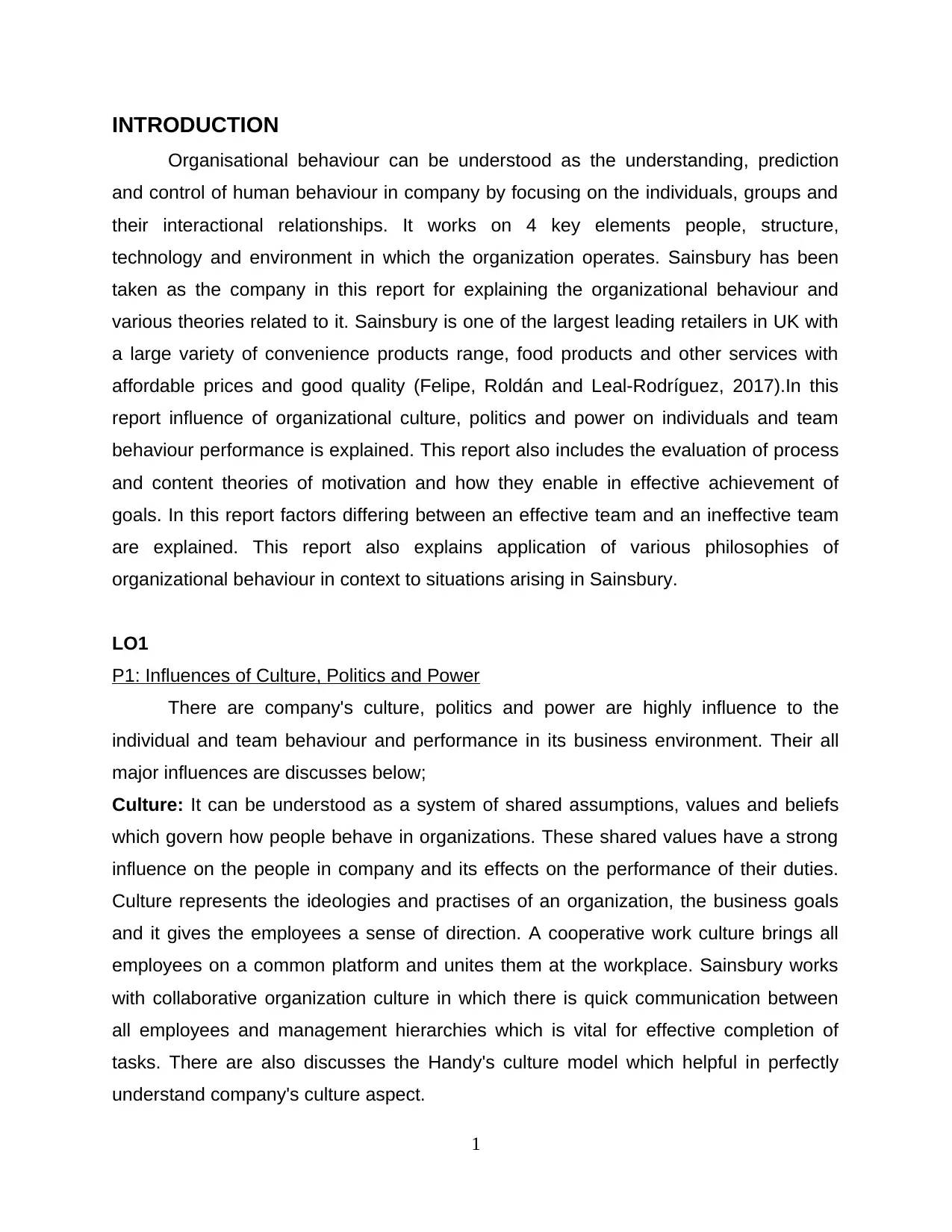
INTRODUCTION
Organisational behaviour can be understood as the understanding, prediction
and control of human behaviour in company by focusing on the individuals, groups and
their interactional relationships. It works on 4 key elements people, structure,
technology and environment in which the organization operates. Sainsbury has been
taken as the company in this report for explaining the organizational behaviour and
various theories related to it. Sainsbury is one of the largest leading retailers in UK with
a large variety of convenience products range, food products and other services with
affordable prices and good quality (Felipe, Roldán and Leal-Rodríguez, 2017).In this
report influence of organizational culture, politics and power on individuals and team
behaviour performance is explained. This report also includes the evaluation of process
and content theories of motivation and how they enable in effective achievement of
goals. In this report factors differing between an effective team and an ineffective team
are explained. This report also explains application of various philosophies of
organizational behaviour in context to situations arising in Sainsbury.
LO1
P1: Influences of Culture, Politics and Power
There are company's culture, politics and power are highly influence to the
individual and team behaviour and performance in its business environment. Their all
major influences are discusses below;
Culture: It can be understood as a system of shared assumptions, values and beliefs
which govern how people behave in organizations. These shared values have a strong
influence on the people in company and its effects on the performance of their duties.
Culture represents the ideologies and practises of an organization, the business goals
and it gives the employees a sense of direction. A cooperative work culture brings all
employees on a common platform and unites them at the workplace. Sainsbury works
with collaborative organization culture in which there is quick communication between
all employees and management hierarchies which is vital for effective completion of
tasks. There are also discusses the Handy's culture model which helpful in perfectly
understand company's culture aspect.
1
Organisational behaviour can be understood as the understanding, prediction
and control of human behaviour in company by focusing on the individuals, groups and
their interactional relationships. It works on 4 key elements people, structure,
technology and environment in which the organization operates. Sainsbury has been
taken as the company in this report for explaining the organizational behaviour and
various theories related to it. Sainsbury is one of the largest leading retailers in UK with
a large variety of convenience products range, food products and other services with
affordable prices and good quality (Felipe, Roldán and Leal-Rodríguez, 2017).In this
report influence of organizational culture, politics and power on individuals and team
behaviour performance is explained. This report also includes the evaluation of process
and content theories of motivation and how they enable in effective achievement of
goals. In this report factors differing between an effective team and an ineffective team
are explained. This report also explains application of various philosophies of
organizational behaviour in context to situations arising in Sainsbury.
LO1
P1: Influences of Culture, Politics and Power
There are company's culture, politics and power are highly influence to the
individual and team behaviour and performance in its business environment. Their all
major influences are discusses below;
Culture: It can be understood as a system of shared assumptions, values and beliefs
which govern how people behave in organizations. These shared values have a strong
influence on the people in company and its effects on the performance of their duties.
Culture represents the ideologies and practises of an organization, the business goals
and it gives the employees a sense of direction. A cooperative work culture brings all
employees on a common platform and unites them at the workplace. Sainsbury works
with collaborative organization culture in which there is quick communication between
all employees and management hierarchies which is vital for effective completion of
tasks. There are also discusses the Handy's culture model which helpful in perfectly
understand company's culture aspect.
1
⊘ This is a preview!⊘
Do you want full access?
Subscribe today to unlock all pages.

Trusted by 1+ million students worldwide
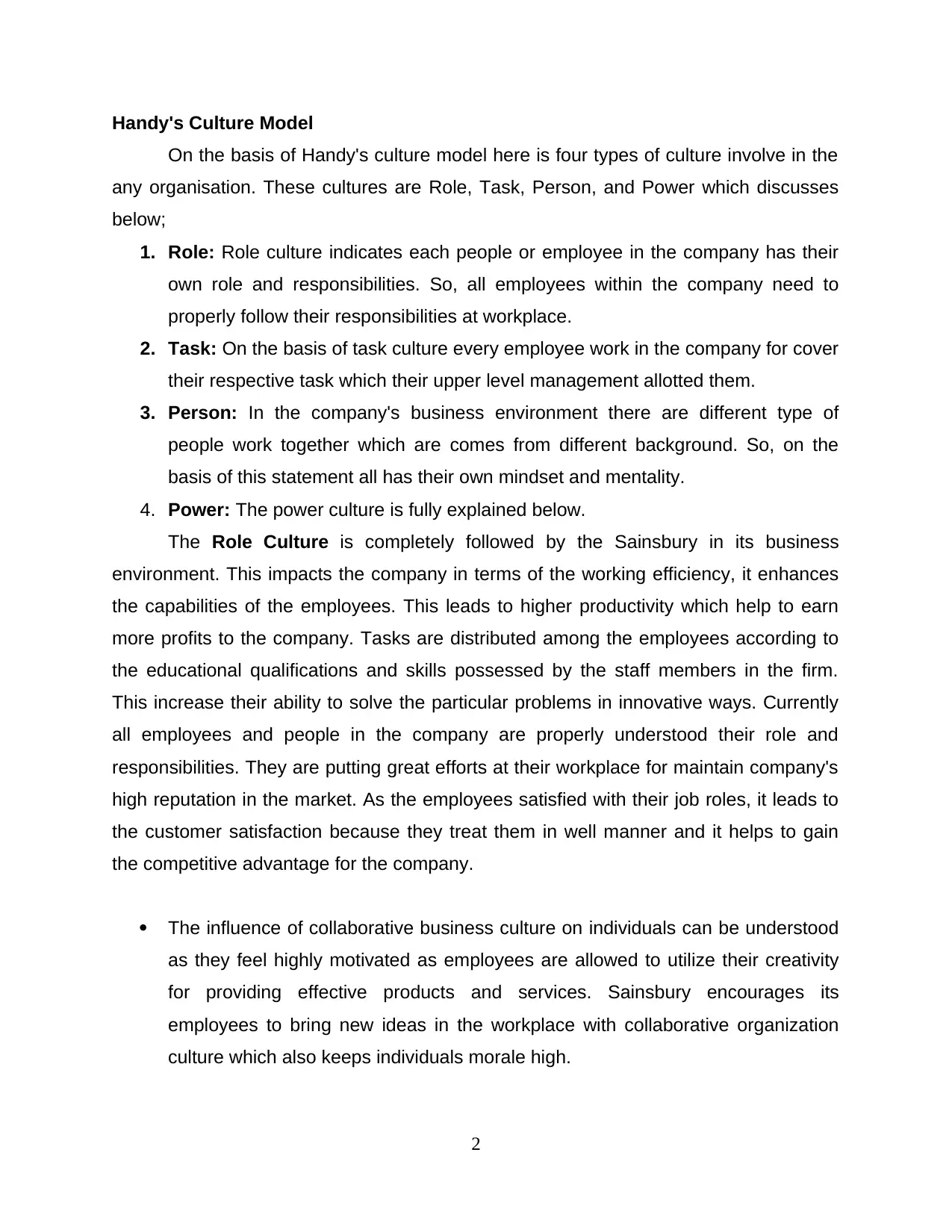
Handy's Culture Model
On the basis of Handy's culture model here is four types of culture involve in the
any organisation. These cultures are Role, Task, Person, and Power which discusses
below;
1. Role: Role culture indicates each people or employee in the company has their
own role and responsibilities. So, all employees within the company need to
properly follow their responsibilities at workplace.
2. Task: On the basis of task culture every employee work in the company for cover
their respective task which their upper level management allotted them.
3. Person: In the company's business environment there are different type of
people work together which are comes from different background. So, on the
basis of this statement all has their own mindset and mentality.
4. Power: The power culture is fully explained below.
The Role Culture is completely followed by the Sainsbury in its business
environment. This impacts the company in terms of the working efficiency, it enhances
the capabilities of the employees. This leads to higher productivity which help to earn
more profits to the company. Tasks are distributed among the employees according to
the educational qualifications and skills possessed by the staff members in the firm.
This increase their ability to solve the particular problems in innovative ways. Currently
all employees and people in the company are properly understood their role and
responsibilities. They are putting great efforts at their workplace for maintain company's
high reputation in the market. As the employees satisfied with their job roles, it leads to
the customer satisfaction because they treat them in well manner and it helps to gain
the competitive advantage for the company.
The influence of collaborative business culture on individuals can be understood
as they feel highly motivated as employees are allowed to utilize their creativity
for providing effective products and services. Sainsbury encourages its
employees to bring new ideas in the workplace with collaborative organization
culture which also keeps individuals morale high.
2
On the basis of Handy's culture model here is four types of culture involve in the
any organisation. These cultures are Role, Task, Person, and Power which discusses
below;
1. Role: Role culture indicates each people or employee in the company has their
own role and responsibilities. So, all employees within the company need to
properly follow their responsibilities at workplace.
2. Task: On the basis of task culture every employee work in the company for cover
their respective task which their upper level management allotted them.
3. Person: In the company's business environment there are different type of
people work together which are comes from different background. So, on the
basis of this statement all has their own mindset and mentality.
4. Power: The power culture is fully explained below.
The Role Culture is completely followed by the Sainsbury in its business
environment. This impacts the company in terms of the working efficiency, it enhances
the capabilities of the employees. This leads to higher productivity which help to earn
more profits to the company. Tasks are distributed among the employees according to
the educational qualifications and skills possessed by the staff members in the firm.
This increase their ability to solve the particular problems in innovative ways. Currently
all employees and people in the company are properly understood their role and
responsibilities. They are putting great efforts at their workplace for maintain company's
high reputation in the market. As the employees satisfied with their job roles, it leads to
the customer satisfaction because they treat them in well manner and it helps to gain
the competitive advantage for the company.
The influence of collaborative business culture on individuals can be understood
as they feel highly motivated as employees are allowed to utilize their creativity
for providing effective products and services. Sainsbury encourages its
employees to bring new ideas in the workplace with collaborative organization
culture which also keeps individuals morale high.
2
Paraphrase This Document
Need a fresh take? Get an instant paraphrase of this document with our AI Paraphraser
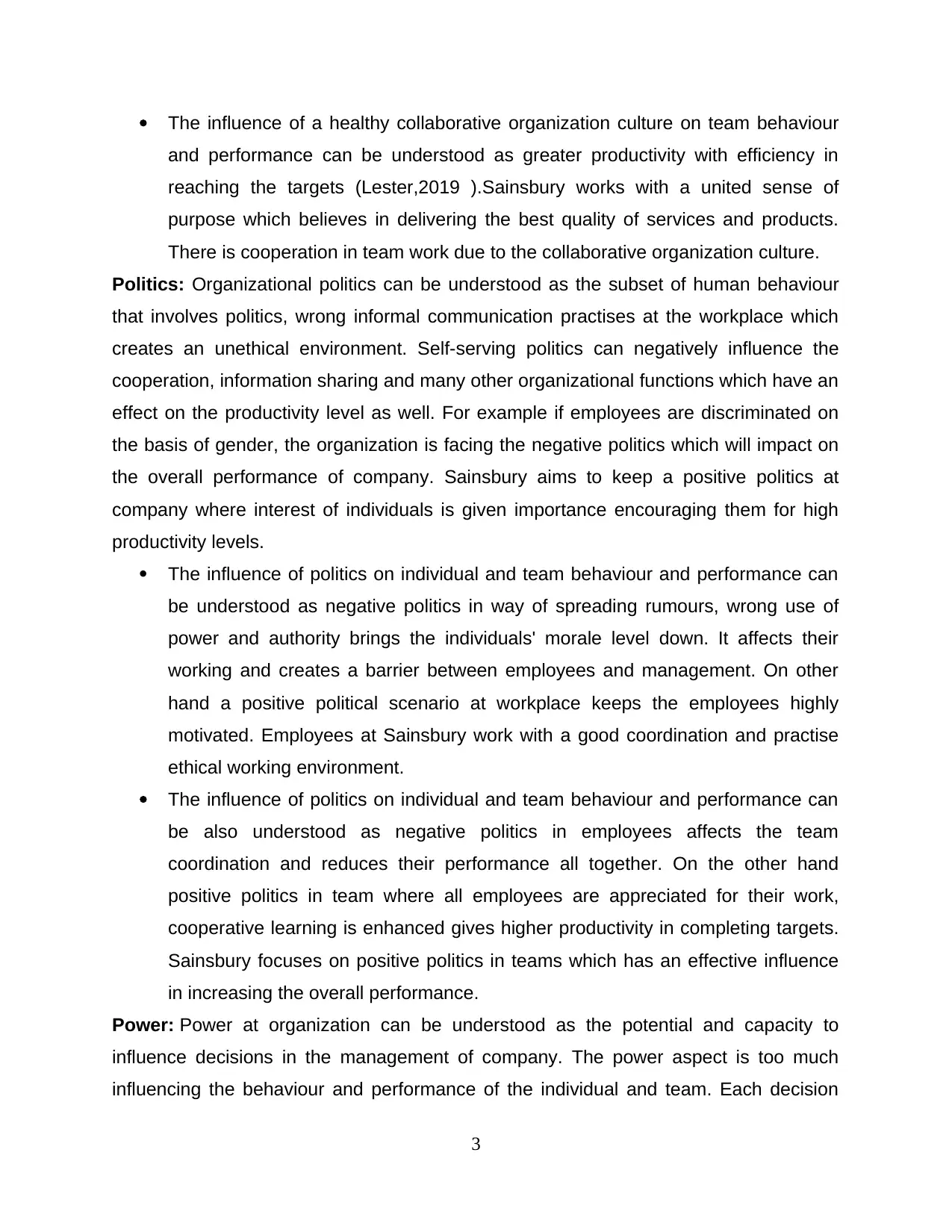
The influence of a healthy collaborative organization culture on team behaviour
and performance can be understood as greater productivity with efficiency in
reaching the targets (Lester,2019 ).Sainsbury works with a united sense of
purpose which believes in delivering the best quality of services and products.
There is cooperation in team work due to the collaborative organization culture.
Politics: Organizational politics can be understood as the subset of human behaviour
that involves politics, wrong informal communication practises at the workplace which
creates an unethical environment. Self-serving politics can negatively influence the
cooperation, information sharing and many other organizational functions which have an
effect on the productivity level as well. For example if employees are discriminated on
the basis of gender, the organization is facing the negative politics which will impact on
the overall performance of company. Sainsbury aims to keep a positive politics at
company where interest of individuals is given importance encouraging them for high
productivity levels.
The influence of politics on individual and team behaviour and performance can
be understood as negative politics in way of spreading rumours, wrong use of
power and authority brings the individuals' morale level down. It affects their
working and creates a barrier between employees and management. On other
hand a positive political scenario at workplace keeps the employees highly
motivated. Employees at Sainsbury work with a good coordination and practise
ethical working environment.
The influence of politics on individual and team behaviour and performance can
be also understood as negative politics in employees affects the team
coordination and reduces their performance all together. On the other hand
positive politics in team where all employees are appreciated for their work,
cooperative learning is enhanced gives higher productivity in completing targets.
Sainsbury focuses on positive politics in teams which has an effective influence
in increasing the overall performance.
Power: Power at organization can be understood as the potential and capacity to
influence decisions in the management of company. The power aspect is too much
influencing the behaviour and performance of the individual and team. Each decision
3
and performance can be understood as greater productivity with efficiency in
reaching the targets (Lester,2019 ).Sainsbury works with a united sense of
purpose which believes in delivering the best quality of services and products.
There is cooperation in team work due to the collaborative organization culture.
Politics: Organizational politics can be understood as the subset of human behaviour
that involves politics, wrong informal communication practises at the workplace which
creates an unethical environment. Self-serving politics can negatively influence the
cooperation, information sharing and many other organizational functions which have an
effect on the productivity level as well. For example if employees are discriminated on
the basis of gender, the organization is facing the negative politics which will impact on
the overall performance of company. Sainsbury aims to keep a positive politics at
company where interest of individuals is given importance encouraging them for high
productivity levels.
The influence of politics on individual and team behaviour and performance can
be understood as negative politics in way of spreading rumours, wrong use of
power and authority brings the individuals' morale level down. It affects their
working and creates a barrier between employees and management. On other
hand a positive political scenario at workplace keeps the employees highly
motivated. Employees at Sainsbury work with a good coordination and practise
ethical working environment.
The influence of politics on individual and team behaviour and performance can
be also understood as negative politics in employees affects the team
coordination and reduces their performance all together. On the other hand
positive politics in team where all employees are appreciated for their work,
cooperative learning is enhanced gives higher productivity in completing targets.
Sainsbury focuses on positive politics in teams which has an effective influence
in increasing the overall performance.
Power: Power at organization can be understood as the potential and capacity to
influence decisions in the management of company. The power aspect is too much
influencing the behaviour and performance of the individual and team. Each decision
3
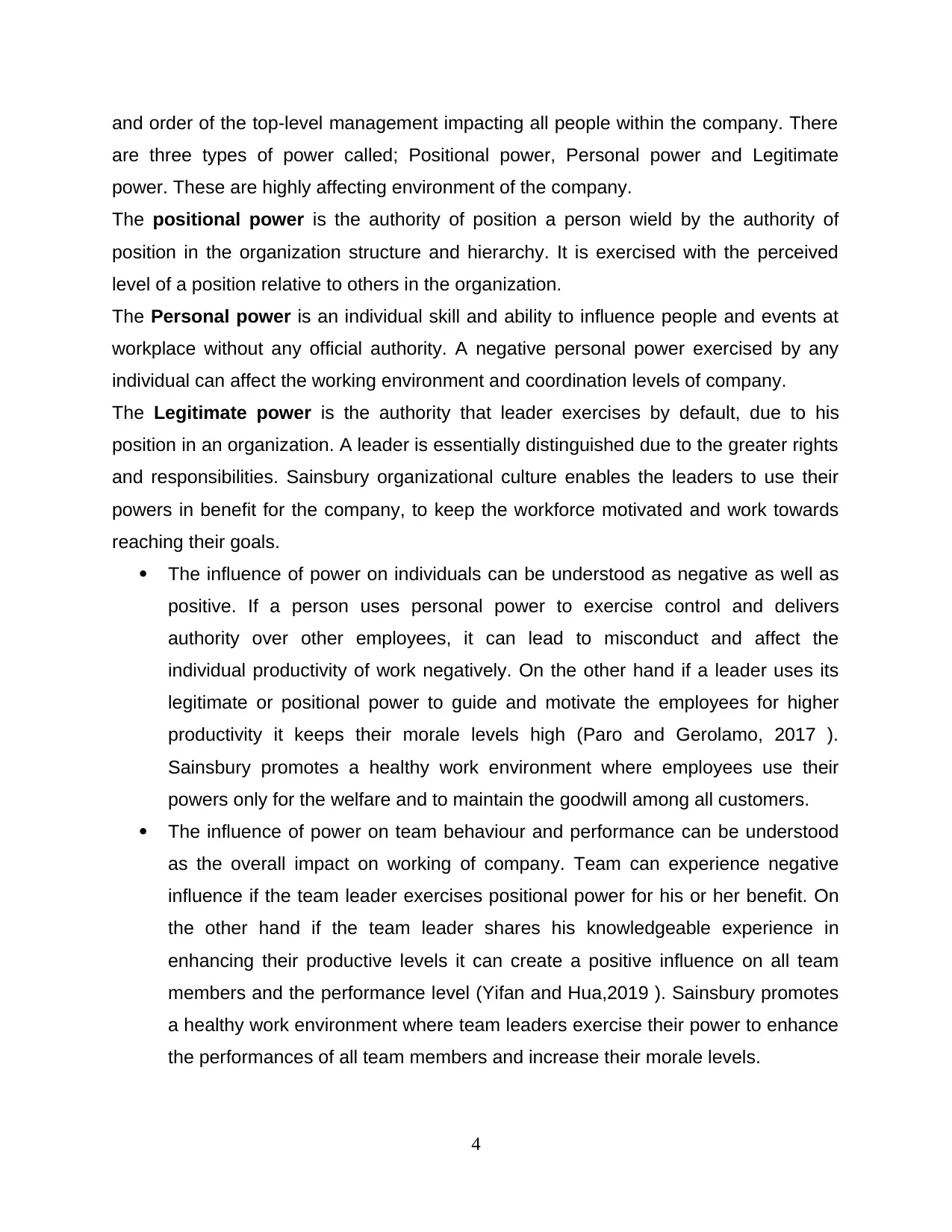
and order of the top-level management impacting all people within the company. There
are three types of power called; Positional power, Personal power and Legitimate
power. These are highly affecting environment of the company.
The positional power is the authority of position a person wield by the authority of
position in the organization structure and hierarchy. It is exercised with the perceived
level of a position relative to others in the organization.
The Personal power is an individual skill and ability to influence people and events at
workplace without any official authority. A negative personal power exercised by any
individual can affect the working environment and coordination levels of company.
The Legitimate power is the authority that leader exercises by default, due to his
position in an organization. A leader is essentially distinguished due to the greater rights
and responsibilities. Sainsbury organizational culture enables the leaders to use their
powers in benefit for the company, to keep the workforce motivated and work towards
reaching their goals.
The influence of power on individuals can be understood as negative as well as
positive. If a person uses personal power to exercise control and delivers
authority over other employees, it can lead to misconduct and affect the
individual productivity of work negatively. On the other hand if a leader uses its
legitimate or positional power to guide and motivate the employees for higher
productivity it keeps their morale levels high (Paro and Gerolamo, 2017 ).
Sainsbury promotes a healthy work environment where employees use their
powers only for the welfare and to maintain the goodwill among all customers.
The influence of power on team behaviour and performance can be understood
as the overall impact on working of company. Team can experience negative
influence if the team leader exercises positional power for his or her benefit. On
the other hand if the team leader shares his knowledgeable experience in
enhancing their productive levels it can create a positive influence on all team
members and the performance level (Yifan and Hua,2019 ). Sainsbury promotes
a healthy work environment where team leaders exercise their power to enhance
the performances of all team members and increase their morale levels.
4
are three types of power called; Positional power, Personal power and Legitimate
power. These are highly affecting environment of the company.
The positional power is the authority of position a person wield by the authority of
position in the organization structure and hierarchy. It is exercised with the perceived
level of a position relative to others in the organization.
The Personal power is an individual skill and ability to influence people and events at
workplace without any official authority. A negative personal power exercised by any
individual can affect the working environment and coordination levels of company.
The Legitimate power is the authority that leader exercises by default, due to his
position in an organization. A leader is essentially distinguished due to the greater rights
and responsibilities. Sainsbury organizational culture enables the leaders to use their
powers in benefit for the company, to keep the workforce motivated and work towards
reaching their goals.
The influence of power on individuals can be understood as negative as well as
positive. If a person uses personal power to exercise control and delivers
authority over other employees, it can lead to misconduct and affect the
individual productivity of work negatively. On the other hand if a leader uses its
legitimate or positional power to guide and motivate the employees for higher
productivity it keeps their morale levels high (Paro and Gerolamo, 2017 ).
Sainsbury promotes a healthy work environment where employees use their
powers only for the welfare and to maintain the goodwill among all customers.
The influence of power on team behaviour and performance can be understood
as the overall impact on working of company. Team can experience negative
influence if the team leader exercises positional power for his or her benefit. On
the other hand if the team leader shares his knowledgeable experience in
enhancing their productive levels it can create a positive influence on all team
members and the performance level (Yifan and Hua,2019 ). Sainsbury promotes
a healthy work environment where team leaders exercise their power to enhance
the performances of all team members and increase their morale levels.
4
⊘ This is a preview!⊘
Do you want full access?
Subscribe today to unlock all pages.

Trusted by 1+ million students worldwide
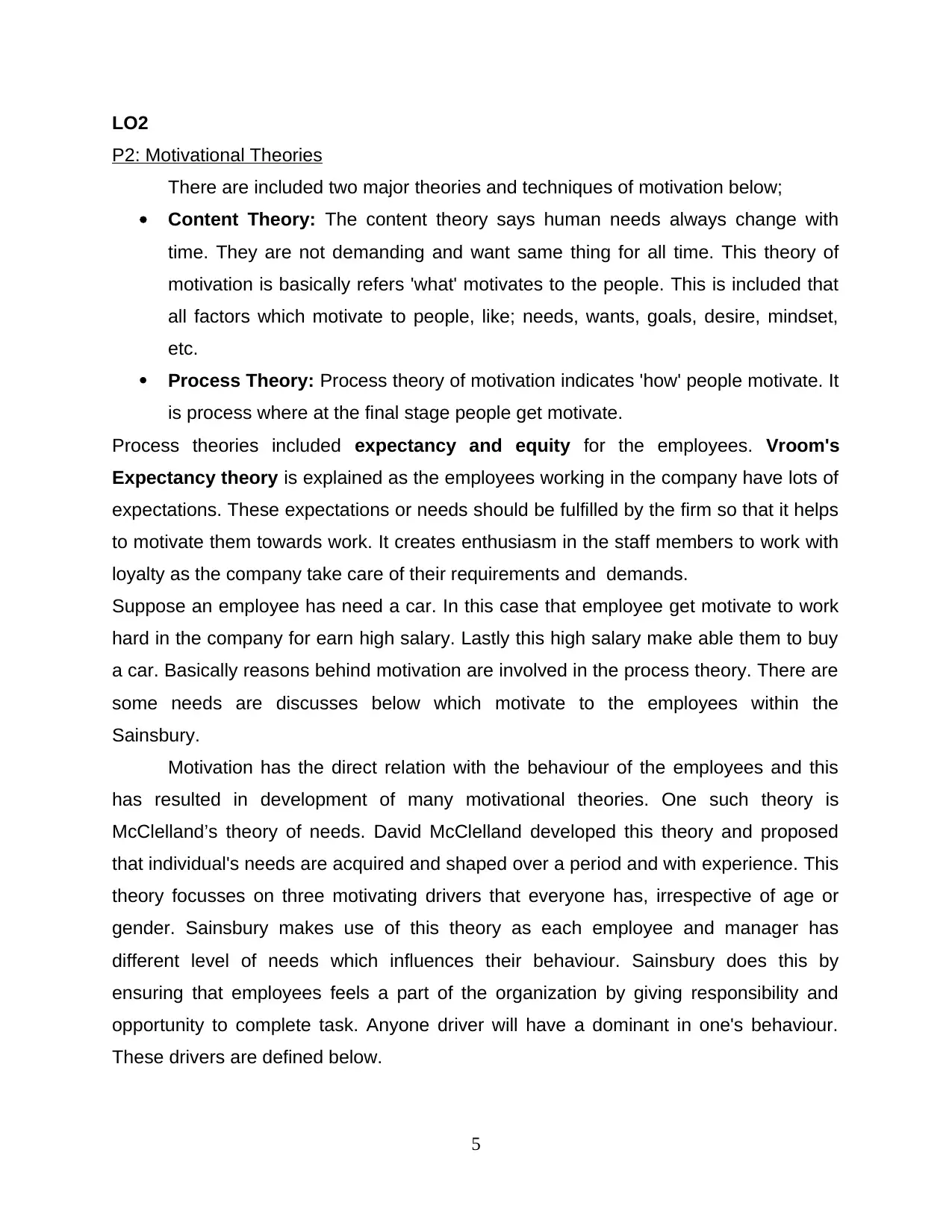
LO2
P2: Motivational Theories
There are included two major theories and techniques of motivation below;
Content Theory: The content theory says human needs always change with
time. They are not demanding and want same thing for all time. This theory of
motivation is basically refers 'what' motivates to the people. This is included that
all factors which motivate to people, like; needs, wants, goals, desire, mindset,
etc.
Process Theory: Process theory of motivation indicates 'how' people motivate. It
is process where at the final stage people get motivate.
Process theories included expectancy and equity for the employees. Vroom's
Expectancy theory is explained as the employees working in the company have lots of
expectations. These expectations or needs should be fulfilled by the firm so that it helps
to motivate them towards work. It creates enthusiasm in the staff members to work with
loyalty as the company take care of their requirements and demands.
Suppose an employee has need a car. In this case that employee get motivate to work
hard in the company for earn high salary. Lastly this high salary make able them to buy
a car. Basically reasons behind motivation are involved in the process theory. There are
some needs are discusses below which motivate to the employees within the
Sainsbury.
Motivation has the direct relation with the behaviour of the employees and this
has resulted in development of many motivational theories. One such theory is
McClelland’s theory of needs. David McClelland developed this theory and proposed
that individual's needs are acquired and shaped over a period and with experience. This
theory focusses on three motivating drivers that everyone has, irrespective of age or
gender. Sainsbury makes use of this theory as each employee and manager has
different level of needs which influences their behaviour. Sainsbury does this by
ensuring that employees feels a part of the organization by giving responsibility and
opportunity to complete task. Anyone driver will have a dominant in one's behaviour.
These drivers are defined below.
5
P2: Motivational Theories
There are included two major theories and techniques of motivation below;
Content Theory: The content theory says human needs always change with
time. They are not demanding and want same thing for all time. This theory of
motivation is basically refers 'what' motivates to the people. This is included that
all factors which motivate to people, like; needs, wants, goals, desire, mindset,
etc.
Process Theory: Process theory of motivation indicates 'how' people motivate. It
is process where at the final stage people get motivate.
Process theories included expectancy and equity for the employees. Vroom's
Expectancy theory is explained as the employees working in the company have lots of
expectations. These expectations or needs should be fulfilled by the firm so that it helps
to motivate them towards work. It creates enthusiasm in the staff members to work with
loyalty as the company take care of their requirements and demands.
Suppose an employee has need a car. In this case that employee get motivate to work
hard in the company for earn high salary. Lastly this high salary make able them to buy
a car. Basically reasons behind motivation are involved in the process theory. There are
some needs are discusses below which motivate to the employees within the
Sainsbury.
Motivation has the direct relation with the behaviour of the employees and this
has resulted in development of many motivational theories. One such theory is
McClelland’s theory of needs. David McClelland developed this theory and proposed
that individual's needs are acquired and shaped over a period and with experience. This
theory focusses on three motivating drivers that everyone has, irrespective of age or
gender. Sainsbury makes use of this theory as each employee and manager has
different level of needs which influences their behaviour. Sainsbury does this by
ensuring that employees feels a part of the organization by giving responsibility and
opportunity to complete task. Anyone driver will have a dominant in one's behaviour.
These drivers are defined below.
5
Paraphrase This Document
Need a fresh take? Get an instant paraphrase of this document with our AI Paraphraser
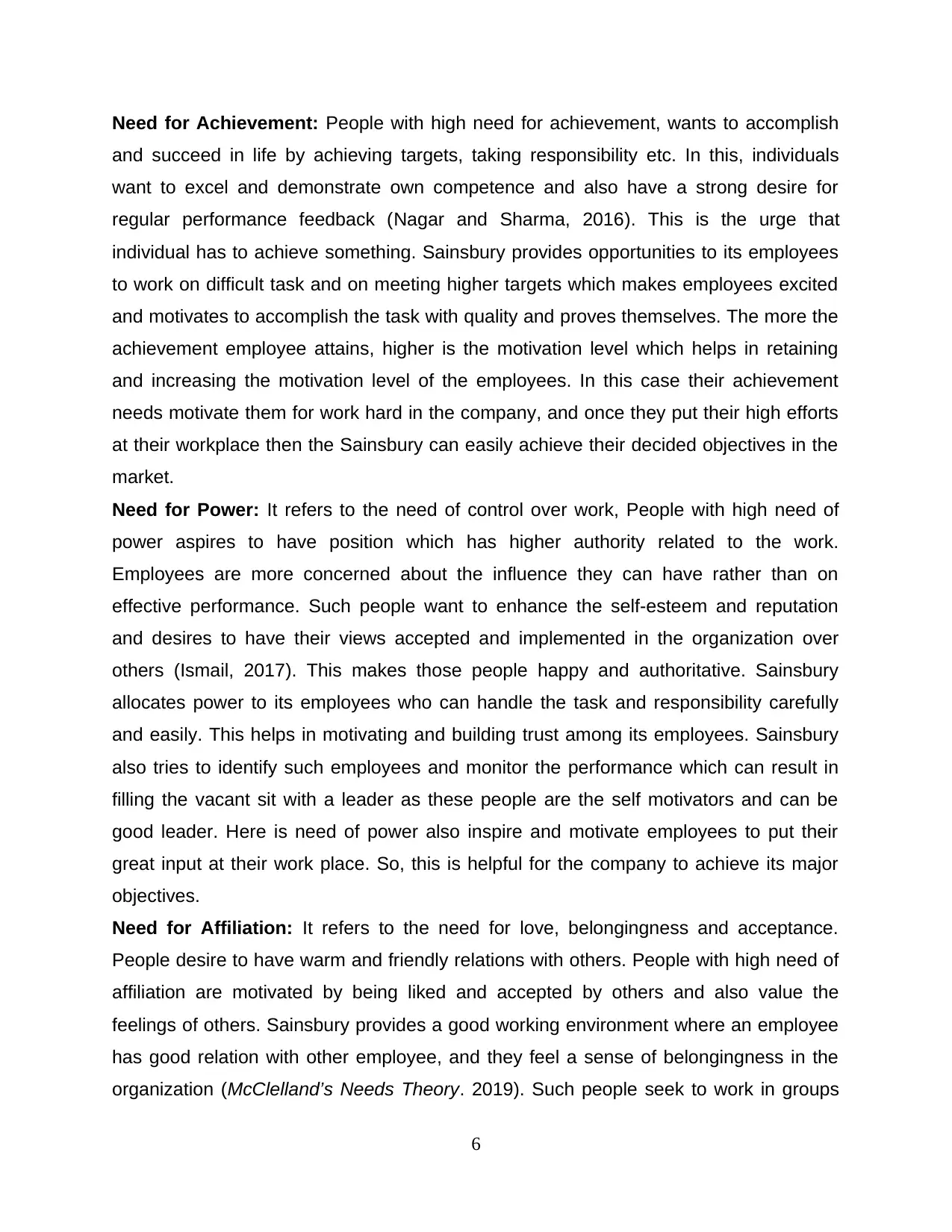
Need for Achievement: People with high need for achievement, wants to accomplish
and succeed in life by achieving targets, taking responsibility etc. In this, individuals
want to excel and demonstrate own competence and also have a strong desire for
regular performance feedback (Nagar and Sharma, 2016). This is the urge that
individual has to achieve something. Sainsbury provides opportunities to its employees
to work on difficult task and on meeting higher targets which makes employees excited
and motivates to accomplish the task with quality and proves themselves. The more the
achievement employee attains, higher is the motivation level which helps in retaining
and increasing the motivation level of the employees. In this case their achievement
needs motivate them for work hard in the company, and once they put their high efforts
at their workplace then the Sainsbury can easily achieve their decided objectives in the
market.
Need for Power: It refers to the need of control over work, People with high need of
power aspires to have position which has higher authority related to the work.
Employees are more concerned about the influence they can have rather than on
effective performance. Such people want to enhance the self-esteem and reputation
and desires to have their views accepted and implemented in the organization over
others (Ismail, 2017). This makes those people happy and authoritative. Sainsbury
allocates power to its employees who can handle the task and responsibility carefully
and easily. This helps in motivating and building trust among its employees. Sainsbury
also tries to identify such employees and monitor the performance which can result in
filling the vacant sit with a leader as these people are the self motivators and can be
good leader. Here is need of power also inspire and motivate employees to put their
great input at their work place. So, this is helpful for the company to achieve its major
objectives.
Need for Affiliation: It refers to the need for love, belongingness and acceptance.
People desire to have warm and friendly relations with others. People with high need of
affiliation are motivated by being liked and accepted by others and also value the
feelings of others. Sainsbury provides a good working environment where an employee
has good relation with other employee, and they feel a sense of belongingness in the
organization (McClelland’s Needs Theory. 2019). Such people seek to work in groups
6
and succeed in life by achieving targets, taking responsibility etc. In this, individuals
want to excel and demonstrate own competence and also have a strong desire for
regular performance feedback (Nagar and Sharma, 2016). This is the urge that
individual has to achieve something. Sainsbury provides opportunities to its employees
to work on difficult task and on meeting higher targets which makes employees excited
and motivates to accomplish the task with quality and proves themselves. The more the
achievement employee attains, higher is the motivation level which helps in retaining
and increasing the motivation level of the employees. In this case their achievement
needs motivate them for work hard in the company, and once they put their high efforts
at their workplace then the Sainsbury can easily achieve their decided objectives in the
market.
Need for Power: It refers to the need of control over work, People with high need of
power aspires to have position which has higher authority related to the work.
Employees are more concerned about the influence they can have rather than on
effective performance. Such people want to enhance the self-esteem and reputation
and desires to have their views accepted and implemented in the organization over
others (Ismail, 2017). This makes those people happy and authoritative. Sainsbury
allocates power to its employees who can handle the task and responsibility carefully
and easily. This helps in motivating and building trust among its employees. Sainsbury
also tries to identify such employees and monitor the performance which can result in
filling the vacant sit with a leader as these people are the self motivators and can be
good leader. Here is need of power also inspire and motivate employees to put their
great input at their work place. So, this is helpful for the company to achieve its major
objectives.
Need for Affiliation: It refers to the need for love, belongingness and acceptance.
People desire to have warm and friendly relations with others. People with high need of
affiliation are motivated by being liked and accepted by others and also value the
feelings of others. Sainsbury provides a good working environment where an employee
has good relation with other employee, and they feel a sense of belongingness in the
organization (McClelland’s Needs Theory. 2019). Such people seek to work in groups
6
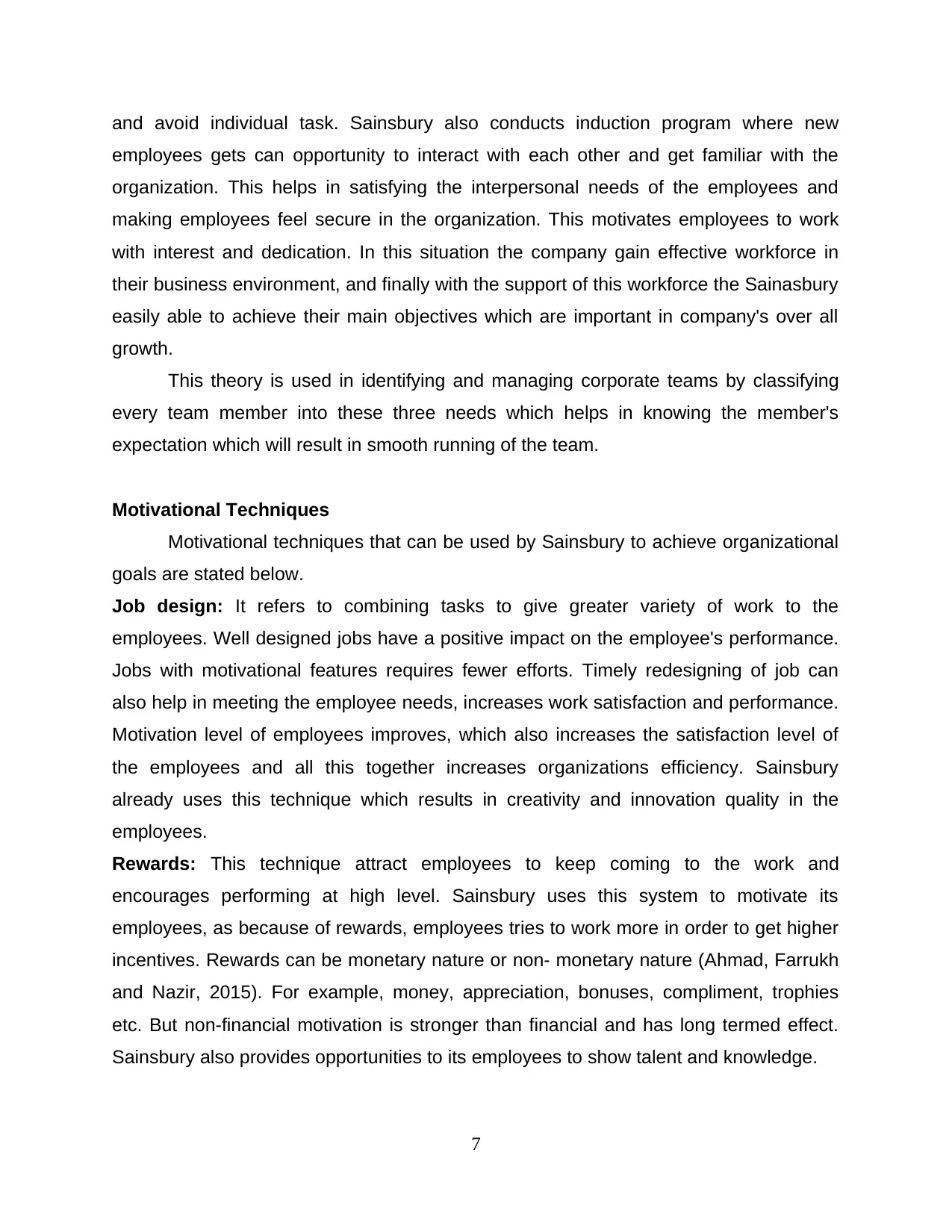
and avoid individual task. Sainsbury also conducts induction program where new
employees gets can opportunity to interact with each other and get familiar with the
organization. This helps in satisfying the interpersonal needs of the employees and
making employees feel secure in the organization. This motivates employees to work
with interest and dedication. In this situation the company gain effective workforce in
their business environment, and finally with the support of this workforce the Sainasbury
easily able to achieve their main objectives which are important in company's over all
growth.
This theory is used in identifying and managing corporate teams by classifying
every team member into these three needs which helps in knowing the member's
expectation which will result in smooth running of the team.
Motivational Techniques
Motivational techniques that can be used by Sainsbury to achieve organizational
goals are stated below.
Job design: It refers to combining tasks to give greater variety of work to the
employees. Well designed jobs have a positive impact on the employee's performance.
Jobs with motivational features requires fewer efforts. Timely redesigning of job can
also help in meeting the employee needs, increases work satisfaction and performance.
Motivation level of employees improves, which also increases the satisfaction level of
the employees and all this together increases organizations efficiency. Sainsbury
already uses this technique which results in creativity and innovation quality in the
employees.
Rewards: This technique attract employees to keep coming to the work and
encourages performing at high level. Sainsbury uses this system to motivate its
employees, as because of rewards, employees tries to work more in order to get higher
incentives. Rewards can be monetary nature or non- monetary nature (Ahmad, Farrukh
and Nazir, 2015). For example, money, appreciation, bonuses, compliment, trophies
etc. But non-financial motivation is stronger than financial and has long termed effect.
Sainsbury also provides opportunities to its employees to show talent and knowledge.
7
employees gets can opportunity to interact with each other and get familiar with the
organization. This helps in satisfying the interpersonal needs of the employees and
making employees feel secure in the organization. This motivates employees to work
with interest and dedication. In this situation the company gain effective workforce in
their business environment, and finally with the support of this workforce the Sainasbury
easily able to achieve their main objectives which are important in company's over all
growth.
This theory is used in identifying and managing corporate teams by classifying
every team member into these three needs which helps in knowing the member's
expectation which will result in smooth running of the team.
Motivational Techniques
Motivational techniques that can be used by Sainsbury to achieve organizational
goals are stated below.
Job design: It refers to combining tasks to give greater variety of work to the
employees. Well designed jobs have a positive impact on the employee's performance.
Jobs with motivational features requires fewer efforts. Timely redesigning of job can
also help in meeting the employee needs, increases work satisfaction and performance.
Motivation level of employees improves, which also increases the satisfaction level of
the employees and all this together increases organizations efficiency. Sainsbury
already uses this technique which results in creativity and innovation quality in the
employees.
Rewards: This technique attract employees to keep coming to the work and
encourages performing at high level. Sainsbury uses this system to motivate its
employees, as because of rewards, employees tries to work more in order to get higher
incentives. Rewards can be monetary nature or non- monetary nature (Ahmad, Farrukh
and Nazir, 2015). For example, money, appreciation, bonuses, compliment, trophies
etc. But non-financial motivation is stronger than financial and has long termed effect.
Sainsbury also provides opportunities to its employees to show talent and knowledge.
7
⊘ This is a preview!⊘
Do you want full access?
Subscribe today to unlock all pages.

Trusted by 1+ million students worldwide
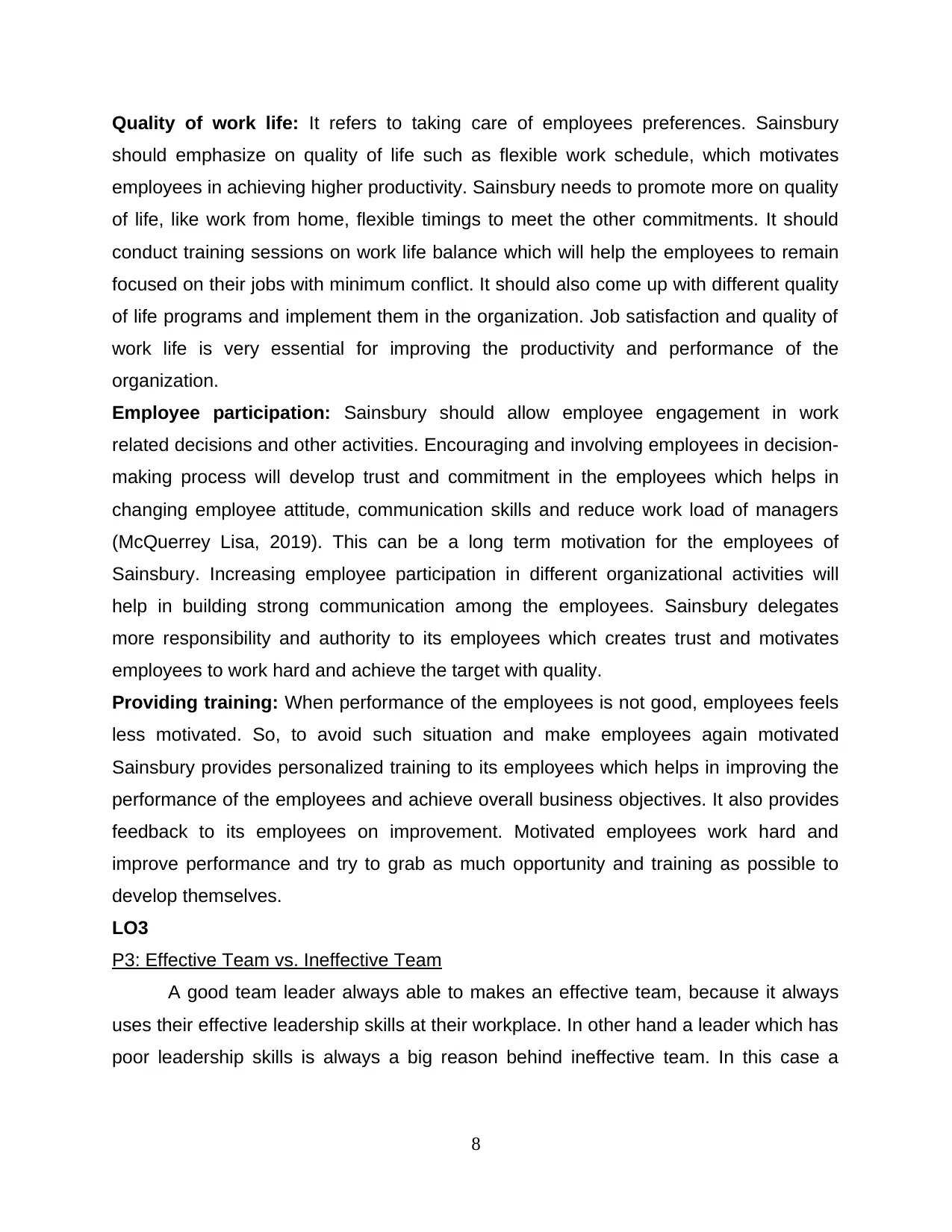
Quality of work life: It refers to taking care of employees preferences. Sainsbury
should emphasize on quality of life such as flexible work schedule, which motivates
employees in achieving higher productivity. Sainsbury needs to promote more on quality
of life, like work from home, flexible timings to meet the other commitments. It should
conduct training sessions on work life balance which will help the employees to remain
focused on their jobs with minimum conflict. It should also come up with different quality
of life programs and implement them in the organization. Job satisfaction and quality of
work life is very essential for improving the productivity and performance of the
organization.
Employee participation: Sainsbury should allow employee engagement in work
related decisions and other activities. Encouraging and involving employees in decision-
making process will develop trust and commitment in the employees which helps in
changing employee attitude, communication skills and reduce work load of managers
(McQuerrey Lisa, 2019). This can be a long term motivation for the employees of
Sainsbury. Increasing employee participation in different organizational activities will
help in building strong communication among the employees. Sainsbury delegates
more responsibility and authority to its employees which creates trust and motivates
employees to work hard and achieve the target with quality.
Providing training: When performance of the employees is not good, employees feels
less motivated. So, to avoid such situation and make employees again motivated
Sainsbury provides personalized training to its employees which helps in improving the
performance of the employees and achieve overall business objectives. It also provides
feedback to its employees on improvement. Motivated employees work hard and
improve performance and try to grab as much opportunity and training as possible to
develop themselves.
LO3
P3: Effective Team vs. Ineffective Team
A good team leader always able to makes an effective team, because it always
uses their effective leadership skills at their workplace. In other hand a leader which has
poor leadership skills is always a big reason behind ineffective team. In this case a
8
should emphasize on quality of life such as flexible work schedule, which motivates
employees in achieving higher productivity. Sainsbury needs to promote more on quality
of life, like work from home, flexible timings to meet the other commitments. It should
conduct training sessions on work life balance which will help the employees to remain
focused on their jobs with minimum conflict. It should also come up with different quality
of life programs and implement them in the organization. Job satisfaction and quality of
work life is very essential for improving the productivity and performance of the
organization.
Employee participation: Sainsbury should allow employee engagement in work
related decisions and other activities. Encouraging and involving employees in decision-
making process will develop trust and commitment in the employees which helps in
changing employee attitude, communication skills and reduce work load of managers
(McQuerrey Lisa, 2019). This can be a long term motivation for the employees of
Sainsbury. Increasing employee participation in different organizational activities will
help in building strong communication among the employees. Sainsbury delegates
more responsibility and authority to its employees which creates trust and motivates
employees to work hard and achieve the target with quality.
Providing training: When performance of the employees is not good, employees feels
less motivated. So, to avoid such situation and make employees again motivated
Sainsbury provides personalized training to its employees which helps in improving the
performance of the employees and achieve overall business objectives. It also provides
feedback to its employees on improvement. Motivated employees work hard and
improve performance and try to grab as much opportunity and training as possible to
develop themselves.
LO3
P3: Effective Team vs. Ineffective Team
A good team leader always able to makes an effective team, because it always
uses their effective leadership skills at their workplace. In other hand a leader which has
poor leadership skills is always a big reason behind ineffective team. In this case a
8
Paraphrase This Document
Need a fresh take? Get an instant paraphrase of this document with our AI Paraphraser
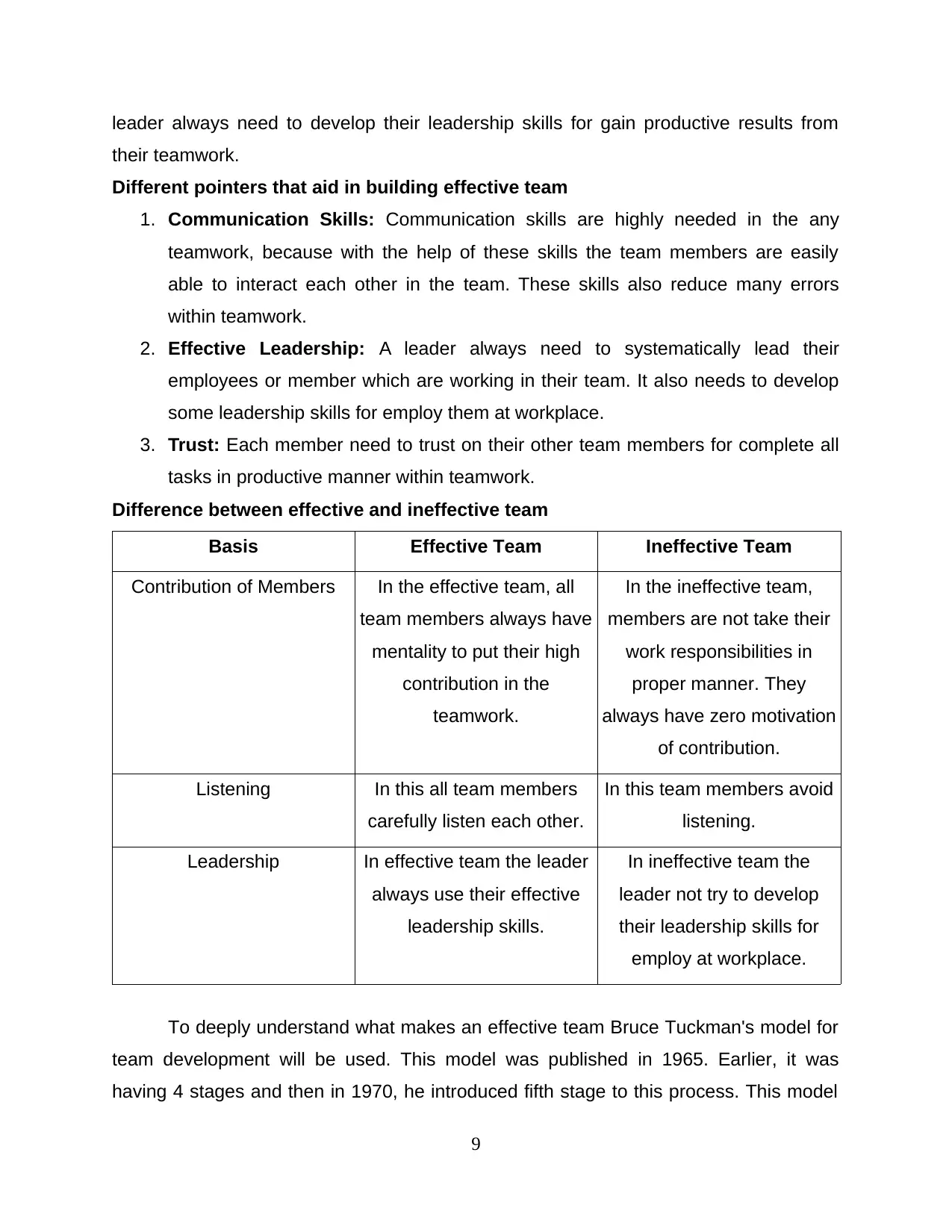
leader always need to develop their leadership skills for gain productive results from
their teamwork.
Different pointers that aid in building effective team
1. Communication Skills: Communication skills are highly needed in the any
teamwork, because with the help of these skills the team members are easily
able to interact each other in the team. These skills also reduce many errors
within teamwork.
2. Effective Leadership: A leader always need to systematically lead their
employees or member which are working in their team. It also needs to develop
some leadership skills for employ them at workplace.
3. Trust: Each member need to trust on their other team members for complete all
tasks in productive manner within teamwork.
Difference between effective and ineffective team
Basis Effective Team Ineffective Team
Contribution of Members In the effective team, all
team members always have
mentality to put their high
contribution in the
teamwork.
In the ineffective team,
members are not take their
work responsibilities in
proper manner. They
always have zero motivation
of contribution.
Listening In this all team members
carefully listen each other.
In this team members avoid
listening.
Leadership In effective team the leader
always use their effective
leadership skills.
In ineffective team the
leader not try to develop
their leadership skills for
employ at workplace.
To deeply understand what makes an effective team Bruce Tuckman's model for
team development will be used. This model was published in 1965. Earlier, it was
having 4 stages and then in 1970, he introduced fifth stage to this process. This model
9
their teamwork.
Different pointers that aid in building effective team
1. Communication Skills: Communication skills are highly needed in the any
teamwork, because with the help of these skills the team members are easily
able to interact each other in the team. These skills also reduce many errors
within teamwork.
2. Effective Leadership: A leader always need to systematically lead their
employees or member which are working in their team. It also needs to develop
some leadership skills for employ them at workplace.
3. Trust: Each member need to trust on their other team members for complete all
tasks in productive manner within teamwork.
Difference between effective and ineffective team
Basis Effective Team Ineffective Team
Contribution of Members In the effective team, all
team members always have
mentality to put their high
contribution in the
teamwork.
In the ineffective team,
members are not take their
work responsibilities in
proper manner. They
always have zero motivation
of contribution.
Listening In this all team members
carefully listen each other.
In this team members avoid
listening.
Leadership In effective team the leader
always use their effective
leadership skills.
In ineffective team the
leader not try to develop
their leadership skills for
employ at workplace.
To deeply understand what makes an effective team Bruce Tuckman's model for
team development will be used. This model was published in 1965. Earlier, it was
having 4 stages and then in 1970, he introduced fifth stage to this process. This model
9
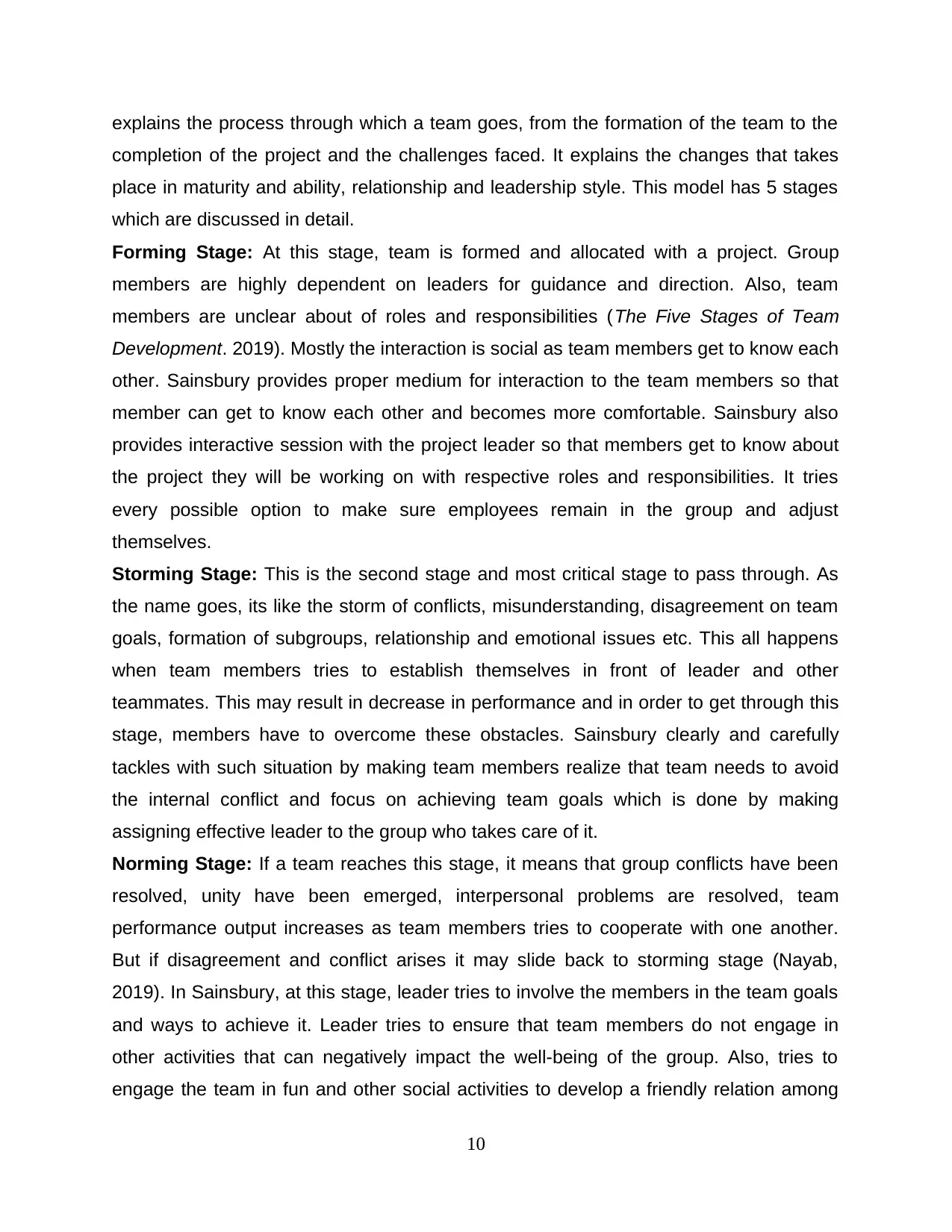
explains the process through which a team goes, from the formation of the team to the
completion of the project and the challenges faced. It explains the changes that takes
place in maturity and ability, relationship and leadership style. This model has 5 stages
which are discussed in detail.
Forming Stage: At this stage, team is formed and allocated with a project. Group
members are highly dependent on leaders for guidance and direction. Also, team
members are unclear about of roles and responsibilities (The Five Stages of Team
Development. 2019). Mostly the interaction is social as team members get to know each
other. Sainsbury provides proper medium for interaction to the team members so that
member can get to know each other and becomes more comfortable. Sainsbury also
provides interactive session with the project leader so that members get to know about
the project they will be working on with respective roles and responsibilities. It tries
every possible option to make sure employees remain in the group and adjust
themselves.
Storming Stage: This is the second stage and most critical stage to pass through. As
the name goes, its like the storm of conflicts, misunderstanding, disagreement on team
goals, formation of subgroups, relationship and emotional issues etc. This all happens
when team members tries to establish themselves in front of leader and other
teammates. This may result in decrease in performance and in order to get through this
stage, members have to overcome these obstacles. Sainsbury clearly and carefully
tackles with such situation by making team members realize that team needs to avoid
the internal conflict and focus on achieving team goals which is done by making
assigning effective leader to the group who takes care of it.
Norming Stage: If a team reaches this stage, it means that group conflicts have been
resolved, unity have been emerged, interpersonal problems are resolved, team
performance output increases as team members tries to cooperate with one another.
But if disagreement and conflict arises it may slide back to storming stage (Nayab,
2019). In Sainsbury, at this stage, leader tries to involve the members in the team goals
and ways to achieve it. Leader tries to ensure that team members do not engage in
other activities that can negatively impact the well-being of the group. Also, tries to
engage the team in fun and other social activities to develop a friendly relation among
10
completion of the project and the challenges faced. It explains the changes that takes
place in maturity and ability, relationship and leadership style. This model has 5 stages
which are discussed in detail.
Forming Stage: At this stage, team is formed and allocated with a project. Group
members are highly dependent on leaders for guidance and direction. Also, team
members are unclear about of roles and responsibilities (The Five Stages of Team
Development. 2019). Mostly the interaction is social as team members get to know each
other. Sainsbury provides proper medium for interaction to the team members so that
member can get to know each other and becomes more comfortable. Sainsbury also
provides interactive session with the project leader so that members get to know about
the project they will be working on with respective roles and responsibilities. It tries
every possible option to make sure employees remain in the group and adjust
themselves.
Storming Stage: This is the second stage and most critical stage to pass through. As
the name goes, its like the storm of conflicts, misunderstanding, disagreement on team
goals, formation of subgroups, relationship and emotional issues etc. This all happens
when team members tries to establish themselves in front of leader and other
teammates. This may result in decrease in performance and in order to get through this
stage, members have to overcome these obstacles. Sainsbury clearly and carefully
tackles with such situation by making team members realize that team needs to avoid
the internal conflict and focus on achieving team goals which is done by making
assigning effective leader to the group who takes care of it.
Norming Stage: If a team reaches this stage, it means that group conflicts have been
resolved, unity have been emerged, interpersonal problems are resolved, team
performance output increases as team members tries to cooperate with one another.
But if disagreement and conflict arises it may slide back to storming stage (Nayab,
2019). In Sainsbury, at this stage, leader tries to involve the members in the team goals
and ways to achieve it. Leader tries to ensure that team members do not engage in
other activities that can negatively impact the well-being of the group. Also, tries to
engage the team in fun and other social activities to develop a friendly relation among
10
⊘ This is a preview!⊘
Do you want full access?
Subscribe today to unlock all pages.

Trusted by 1+ million students worldwide
1 out of 18
Related Documents
Your All-in-One AI-Powered Toolkit for Academic Success.
+13062052269
info@desklib.com
Available 24*7 on WhatsApp / Email
![[object Object]](/_next/static/media/star-bottom.7253800d.svg)
Unlock your academic potential
Copyright © 2020–2025 A2Z Services. All Rights Reserved. Developed and managed by ZUCOL.





